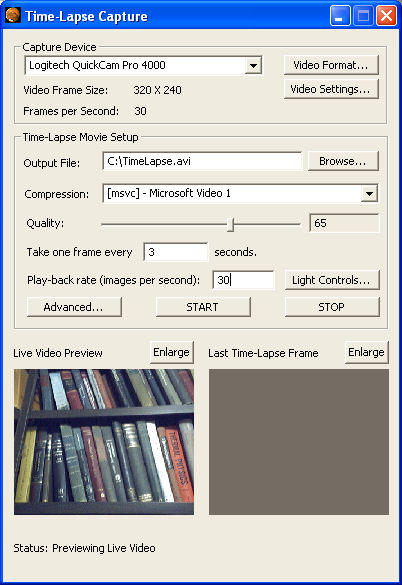
Time-Lapse Imaging
What is time-lapse photography?
Time-lapse photography is a way to make movies where the action appears to be greatly speeded up.
First we need to understand how movies work. Movies are made up of a series of images that are displayed rapidly one at a time. Typically, the images of a normal movie are captured at intervals of 1/16th of a second and played back at 1/16 of a second. Humans, when they see images presented this rapidly, cannot tell the difference between the movie and what they would have seen had they been at the site where the movie was recorded.
A time-lapse movie is a movie created by capturing images separated by times much longer than 1/16 of a second. When these images are played back at a rate of 1/16 of a second between frames, then any motion in whatever was being photographed appears to be greatly speeded up.
(We've made some very interesting images of clouds using 10 seconds delay between each image.)
Why would we want to do time-lapse photography?
There are many things in the world that happen very slowly. So slowly that we are generally unable to appreciate their beauty and complexity unless we speed up the action.
Some examples of things that might be good subjects for time-lapse imaging might include:
- clouds moving
- flowers opening
- traffic on freeways
- boats moving on a lake or the ocean
- ants moving about their nest
- construction of buildings, bridges and freeways
- birds growing up in a nest
- shadows caused by the sun’s motion
- plants growing
- cell-division using a microscope
- ice melting
- snow melting
- etc.
HandyAvi makes it very easy to create and display time-lapse movies using almost any webcam.
Project for anyone so inclined:
Long ago, when time-lapse cameras cost thousands of dollars and we could not afford one, we encountered something that we would have liked to have captured using a time-lapse camera. As far as we know, no one has reported the phenomena that will be described here. In fact we do not know if it is a repeatable process or whether our observations were a fluke. Anyway, here is what was observed:
We were working in an office in Virginia. One of the guys brought in an avocado seed, a small brandy snifter, and three toothpicks. He stuck the toothpicks into the avocado seed and used them to support the avocado seed on the rim of the brandy snifter so that when water was placed in the brandy snifter, half of the avocado seed would be underwater and the rest would be above the water. He kept the brandy snifter on his desk where we all could see it every day.
Over a period of days, the avocado sprouted and roots began to grow. Nothing grew from the top of the avocado seed while the roots continued to grow. They grew pretty straight and at all angles below the water.
When the tips of the roots just barely touched the glass, the roots seemed to stop growing and greenery then began to grow from the top of the avocado seed.
The guy that owned the avocado then brought in a larger brandy snifter and transferred the avocado to it.
That is when the strange thing happened. The roots now were no longer touching the bottom of the glass. The greenery seemed to stop growing. The roots began growing again. No greenery seemed to grow until the roots again just barely touched the bottom of the new glass. Then the roots seemed to stop growing and the greenery began growing again!
It would be very interesting to have a time-lapse movie of this phenomena to verify that it was not a fluke.
If it was not a fluke, then we would wonder how the plant "knew" it was "root bound" and how it communicated signals (presumably chemically?) to control the growth of the greenery.
YOU could be the first to capture this in a video...
If you do make a video of this, please consider sending it to us so we can put it out as one of our example movies!
HandyAvi's Time-lapse image capture control window:
